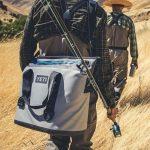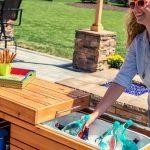There’s nothing better than relaxing around a burning fire or simply spending time fireside with family and friends late into the evening. A backyard fire pit setup transforms a dull evening into a lively, welcoming, and enjoyable setting for making memories.
A fire pit is an excellent feature for any backyard and comes in various styles and designs, including propane [link to Outdoor Propane Fireplace – How To Choose & Set Up], wood-burning, and natural gas-fueled fire pits. Each one has its distinct way of lighting a fire, but lighting a fire in fire pits can be dangerous.
Whether you’re trying to start a fire for cooking at the campsite or require light and warmth when the night falls over your backyard, knowing how to create a fire in a fire pit safely is vital.
You can use fire-starter logs as you master starting a fire much simpler, but our six pro tips are the best way to start a wood fire in a regular fire pit. So, to impress your family and friends with your bonfire skills, here are a few pro tips to follow.
You may also like: Outdoor Propane Fireplace – How To Choose and Set-Up
Before You Begin
It is a no-brainer to always check with the local laws to ensure that you have legal permission to place a fire pit in your backyard.
If you intend to start a fire in a fire pit, you must know how to set up the fire pit correctly. If the fire pit is burning wood without a proper fire suppression system, the flames could extend to the lawn, the deck, leaves, the shed, or even the home.
Even if you don’t see embers or flames, wood fire pits can store enough heat to ignite the wood. Always follow the steps below and any special instructions that come with your fire pit to ensure that you have extinguished the flames and put out the embers. Make it a routine to keep an empty water bucket or a fire extinguisher near in case of an emergency.
An unattended fire takes around 20 minutes to extinguish completely, so don’t leave the area until you’ve had enough time to control and put out the flames adequately. It is also essential to ensure the pit and surrounding areas are free from dry leaves, dry wood, twigs, or other things to save yourself from the tedious process of putting out the fire. Again, buying and keeping an extinguisher nearby is your best bet.
How to Start a Fire in a Fire Pit – 6 Pro Tips
Collect Your Tools & Materials
The tools and materials you’ll need to start a fire in a fire pit:
- Bucket
- Firewood
- Tinder
- Lighter/Matches
- Kindling
- Long stick or poker
- Shovel
- Fire extinguisher
- Steel and flint (optional)
1. Search for small dry materials to use as the tinder.
You can’t just pile the firewood on and then expect an igniter or lighter to light it. Large logs aren’t easy to light. So, first, purchase a sparking device, tinder pile, or fuel to start the outdoor fire or search for smaller dry materials such as dry grass, leaves, shredded tree bark, wood shavings, and newspapers.
Manufactured tinder bundles and fire starters are easy to use and simple to locate. The only downside is you’re paying for something you can find in the woods or even in your backyard.

2. Find dried sticks or twigs for making a kindling teepee.
Tinder gets the flames going, but it burns up quickly unless you have some kindling before the larger fire logs start to ignite. You can also find kindling in pre-made bundles, which are often coated with flammable resins to facilitate the start of the fire, but look around your backyard, campsite, or the forest for dry twigs and sticks to make fuel to light your fire.
Although these materials don’t ignite like the kindling you buy from a store, they’re generally inexpensive or free. If you cannot find sticks, think about cutting a large piece of wood into a kindling using an ax.
3. Make the fire using tinder, fuelwood, and kindling.
Fire won’t light without an oxygen source. If there is no ventilation, the fire will not breathe and won’t burn or stay lit. If you don’t construct an ideal setup for the fire, the logs could collapse, decreasing the airflow and causing sparks to fly out of the fire pit.
You can build your fire in different ways:
- Crossfire construction: Position the tinder material in the middle of the fire pit, then place the kindling over the igniter in a crisscrossing pattern. Next, add the logs for fuel in a similar crisscross design to leave space for air circulation.
- Teepee construction: Place the tinder in the middle of the fireplace pit. Then, stack the kindling pieces vertically around it, leaving an opening at one end. Repeat the process using wood logs for fuel, leaving the same space to allow ventilation.
- Log-cabin fire structure: Like the two other alternatives, place the tinder material in the middle of the fireplace pit. Then, stack the pieces of kindling horizontally in a teepee-like structure around the fire pit’s tinder material.
In this stage, the design should resemble a teepee. First, put two fuelwood logs on either side of the teepee. Next, place two more wood logs parallel to the first two logs on each side of the teepee. Repeat this process once or twice more to complete the log-cabin fire design.
4. Ignite the tinder to start your fire.
After setting up the fire and making sure the structure and ventilation are good, it’s time to ignite the flame. You can use matches, lighters, or even a flint and steel set for a weatherproof alternative.
Use your preferred method to light it, but be sure to ignite it from multiple angles to create an even and consistent burn. For example, if you’re using a flint and steel set, keep the steel near the tinder pile and then hit the flint with the steel to sparks to avoid any problems.
5. Maintain and monitor your fire.
The flames grow quickly, so keep an eye on the fire to minimize spreading and prevent it from bursting. Keep the fire going with the help of a poker or long stick to move heated coals, the embers from the ashes of the tinder, and the kindling heap to boost the temperature.
Also, blow air on the coals to help move oxygen into your fire pit. Use the poker on fuel logs to cut off pieces of charred wood and expose fresh wood to the flame. You can add more fuel logs as required to keep the flame burning.
6. Put out the fire.
When you finish with your hang-out and are ready to put out the fire, start at least 20 minutes ahead of time, as it takes a slow and thorough process to settle down. If you don’t plan to use the fire pit again for a few days, slowly pour a bucket of water onto the flames to put them, coals, and any remaining heat out.
Use a stick or poker to move the coals, ashes, and embers around to look for evidence of steam or any sounds of hissing. If the fire pit remains steaming or hissing, the fire isn’t settled. Fill the bucket, then pour it onto the pit again to keep the fire quiet and calm.
If you plan to use the fire pit again soon, sprinkle water on it to cool the embers and smother the ashes. Don’t let the fire pit soak in water as long as you plan to rebuild it in the next day or so. Instead, turn over the ashes and embers using a shovel, and keep sprinkling water until there’s no heat, steam, or sound coming through the fireplace.
Alternatively, you could use dirt or sand to extinguish the flame. However, you’ll have to scrub the mud or sand out of the fire pit before you can reuse it.

Fire Pit Safety Tips
Follow these fire safety rules for starting the fire in your pit:
- Setting the fire pit: Make sure that your fire pit area is on even ground. Particularly, make sure the structure of your fire pit is elevated above the ground, so it won’t tip over, spilling hazardous materials when it is lit.
- A safe ground material and surface: Use ground constructed of something fire-resistant. Don’t start the fire with lots of dry grass or materials around because they are potentially explosive. Instead, we advise constructing your fire pit on solid materials like brick or concrete that won’t ignite a fire.
- Keep a safe distance from structures: Set the outdoor fire pit 10 feet from all constructions. Also, the fire pits shouldn’t be placed under tree branches, where embers can rise and catch fire.
- Water source nearby: You should have the garden hose or a bucket full of water ready if you’re required to extinguish the flame in an emergency.
- Fire pit screens: If your fire pit has a screen, use it. It still generates sufficient heat and thrill for people to enjoy it but doesn’t allow the embers or any flammable material to escape from the pit.
- Be aware of your surroundings: Chairs surrounding the fire pit must be at a safe distance away so that on the off chance the chair slips accidentally, nobody is at risk of being thrown into the fire (especially during a campfire).
- Watch children: A fire is a thrilling and attractive activity for young children. Keep watch whenever you are near a fire and don’t let them get closer to the pit.
- Never let a fire go unattended: The safety hazards mentioned above are avoidable by having an adult watch the fire throughout the day. Someone must monitor the fire until your clear it out at night.
Conclusion
Follow your local guidelines for installing a backyard fire pit or setting a campfire during a trip. Fortunately, in most places, you can do this at home without compromising your fun.
We hope this article helps you get the perfect fire in a fireplace and take your bonfire game up a notch. Use whatever method is best suited for you; remember the fire pit safety tips as you do so. Additionally, we recommend covering the fire pit when set in a fixed location or relocating it to a protected space away from the rain and wind.
Frequently Asked Questions
Can I cook on my fire pit?
If you have a regular wood bonfire fire pit, it can be safe to cook on! However, you need to proceed with caution. Only cook on clean fires that are free of debris and plastics, only burning untreated natural woods. If you are burning paint-covered wood or materials like plastic or cans, dangerous chemical by-products can affect your food.
Can I put a fire pit under a covering, like a gazebo?
A wood fire should never be placed under a covering like a gazebo. Even if there are open sides to the structure, there is a risk of allowing smoke and heat to build up under the roof of the structure. Having your fire covered greatly increases the risk of fire hazard accidents.
Can I put a fire pit on a wood deck?
No, you should not install a fire pit on top of a wood deck. Even if you try to create a stone base for the fire pit, it will still create a huge potential fire hazard.






